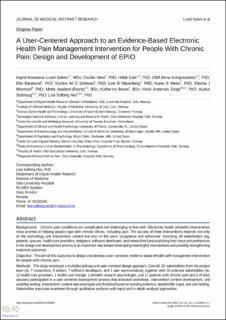| dc.description.abstract | Background: Chronic pain conditions are complicated and challenging to live with. Electronic health (eHealth) interventions show promise in helping people cope with chronic illness, including pain. The success of these interventions depends not only on the technology and intervention content but also on the users’ acceptance and adherence. Involving all stakeholders (eg, patients, spouses, health care providers, designers, software developers, and researchers) and exploring their input and preferences in the design and development process is an important step toward developing meaningful interventions and possibly strengthening treatment outcomes.
Objective: The aim of this study was to design and develop a user-centered, evidence-based eHealth self-management intervention for people with chronic pain.
Methods: The study employed a multidisciplinary and user-centered design approach. Overall, 20 stakeholders from the project team (ie, 7 researchers, 5 editors, 7 software developers, and 1 user representative), together with 33 external stakeholders (ie, 12 health care providers, 1 health care manger, 1 eHealth research psychologist, and 17 patients with chronic pain and 2 of their spouses) participated in a user-centered development process that included workshops, intervention content development, and usability testing. Intervention content was developed and finalized based on existing evidence, stakeholder input, and user testing. Stakeholder input was examined through qualitative analyses with rapid and in-depth analysis approaches.
Results: Analyses from stakeholder input identified themes including a need for reliable, trustworthy, and evidence-based content, personalization, options for feedback, behavioral tracking, and self-assessment/registration as factors to include in the intervention. Evidence-based intervention content development resulted in one face-to-face introduction session and 9 app-based educational and exercise-based modules. Usability testing provided further insight into how to optimize the design of the intervention to the user group, identifying accessibility and a simple design to be essential.
Conclusions: The design and development process of eHealth interventions should strive to combine well-known evidence-based concepts with stakeholder input. This study, designing and developing the pain management intervention EPIO, illustrates how a stakeholder-centered design approach can provide essential input in the development of an eHealth self-management intervention for people with chronic pain. | en_US |
